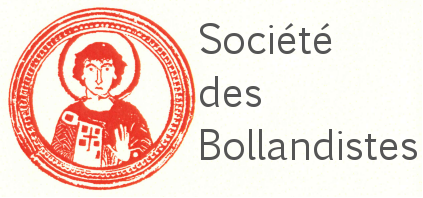Image provided by Hill Museum & Manuscript Library, Saint John’s University, Collegeville, Minnesota under the terms of the Creative Commons Attribution 4.0 International License.
BHSE introduction
The second volume of the Gateway to the Syriac Saints, the Bibliotheca Hagiographica Syriaca Electronica or BHSE, focuses on Syriac hagiographic texts. The BHSE contains the titles of over 1800 Syriac stories, hymns, and homilies on saints. It also includes authors' or hagiographers' names, the first and last lines of the texts, bibliographic information, and the names of the manuscripts containing these hagiographic works. We have also listed modern and ancient translations of these works.
General Editors
- Jeanne-Nicole Mellon Saint-Laurent
- David A. Michelson
- Ugo Zanetti
- Claude Detienne
Editorial Committee
- Chair: Dr. Jeanne-Nicole Mellon Saint-Laurent, Marquette University
- Dr. André Bingelli, Institut de recherche et d’histoire des textes, Centre National de la Recherche Scientifique, Paris
- Dr. Claude Detienne, Instituto de Filosofia e Teologia de Goiás, Brazil
- Dr. Maria Doerfler, Duke University
- Ex Officio: Dr. David Michelson, Vanderbilt University
- Dr. Sr. Jincy Othottil, Chaldean Syrian College, India
- Dr. Aho Shemunkasho, Salzburg University
- Dr. Jack Tannous, Princeton University
- Fr. Ugo Zanetti, Monastère de Chevetogne
Bibliotheca Hagiographica Syriaca Electronica -- BHSE
The second database contained within the Gateway to the Syriac Saints is entitled the Bibliotheca Hagiographica Syriaca Electronica or BHSE. The BHSE is organized around literary works, specifically Syriac saints' lives or vitae. This database is a project inherited from Fr. Ugo Zanetti and his student Dr. Claude Detienne, the Bibliotheca Hagiographica Syriaca. In the 1990s, they collated data pertaining to over 1800 texts on saints from the Syriac tradition along with the incipit, desinit, and other parts of these texts (Zanetti, 1993). They also gathered information on the manuscripts that contain these hagiographic works as well as secondary literature on them.
Fr. Zanetti and Dr. Detienne generously passed on their work to Syriaca.org, and we have updated and developed their data into the BHSE. We have encoded their data in TEI, so that titles, manuscript references, and bibliography (primary and secondary) can be searchable and linkable with any other databases and library catalogues. This will allow scholars to find new hagiographies to be edited and translated, as well as give scholars insights into the popularity and circulation of these stories in antiquity. It also helps scholars to study the cult of an individual saint. In some cases, for instance, several Lives or memre may exist on a single saint who enjoyed particular popularity. Our database enables scholars to see the relationships between these texts and see how the portraits of a single saint can vary greatly from text to text. Because the data will be linked to other modules in Syriaca.org, like manuscripts and place names, scholars can quickly find information about multiple aspects of the stories.
The BHSE includes texts written on both saints and biblical characters that were memorialized in hagiographies, homilies, or hymns. A scholar may be interested, for example, in the homilies and hagiographic poems on Mary, Mother of God. Through our searchable database, the scholar would quickly find four major Syriac authors, Ephrem, Severus, Narsai, and Jacob of Serug, who produced one or more hymns or homilies on Mary. The scholar could then see which have been edited, translated or published. Depending on the interests of the scholar, such searching could lead to the production of a new edition or a comparative study of Mariology in the Syriac tradition. With increased digitizing of manuscripts from major library collections throughout the world, together with open access to our data and the free sharing of our code, our project can benefit scholars worldwide, even those who are far from a major library or research center.
BHSE (Bibliotheca Hagiographica Syriaca Electronica)
C’est en 1898 que parut, la première édition de la BHG (Bibliotheca hagiographica graeca), due au P. Hippolyte Delehaye, Bollandiste 1 . Elle énumérait les Vies des saints par ordre alphabétique, distinguant les diverses recensions grâce à leur incipit (début du texte) et leur desinit (fin du texte). Cette idée géniale a profondément modifié la manière de travailler dans le domaine de l’hagiographie : conçue au départ comme un répertoire de textes publiés, elle prit de plus en plus d’ampleur, notamment grâce à la prise en compte des textes inédits, identifiés grâce aux catalogues de manuscrits, ou parfois à l’examen direct des manuscrits. Ainsi constituée, une « bibliothèque hagiographique » permet à l’utilisateur de se rendre compte d’un coup d’œil de l’étendue du dossier d’un saint donné. Si la Bibliotheca hagiographica latina et la Bibliotheca hagiographica graeca ont pu être tenues à jour, et sont à présent passées (ou sont sur le point de le faire) au format électronique 2 , la Bibliotheca hagiographica orientalis du P. Paul Peeters (parue en 1910) est plus que largement dépassée. Il importe d’en continuer la méthode, mais en l’adaptant aux conditions d’aujourd’hui.
Cela implique, d’une part, que chaque langue de l’Orient chrétien soit présentée séparément, et d’autre part que l’on profite de l’électronique pour mettre à disposition des chercheurs un outil facile à consulter de n’importe quel endroit du monde ; il importe également de tenir compte des catalogues de manuscrits, dans la mesure où ils sont suffisamment précis, pour signaler les inédits, et préciser quels sont les manuscrits qui les contiennent ; enfin, vu que les textes circulaient largement d’une langue à l’autre, il est utile d’attirer l’attention, lorsque c’est possible, sur l’existence de versions parallèles attestées dans d’autres langues — souvent plus anciennes que l’original grec, voire unique témoin d’un original grec disparu —, ainsi que d’éventuelles publications traitant de ce texte.
Un projet de constitution d’une Bibliotheca hagiographica syriaca avait été mis au point 3 ; les circonstances n’ont pas permis de l’achever dans la forme prévue, quoiqu’un matériel considérable ait été recensé et digitalisé par le Dr Claude Detienne de 1993 à 19964, en s’efforçant de respecter les critères ci-dessus. Quoiqu’on ne puisse, cela va de soi, garantir l’exhaustivité, un réel effort a été accompli pour « ratisser large ». Il est donc particulièrement heureux que le Dr Jeanne-Nicole Mellon Saint-Laurent ait pu reprendre le projet et le mener à bien, dans le cadre du projet « The Syriac Reference Portal », avec l’aide de nombreux collaborateurs.
Il va de soi que le fichier présenté ici pourra être ultérieurement accru et amélioré, avec l’aide de tous les syriacisants, qui sont invités à être à la fois utilisateurs et collaborateurs de cette base de données, pour le plus grand profit de tous, dans l’espoir qu’il contribue à une meilleure connaissance non seulement de la littérature syriaque, mais surtout des Églises et des chrétiens d’Orient, qu’ils parlent aujourd’hui le syriaque ou l’arabe.
P. Ugo Zanetti
Monastère de Chevetogne (Belgique)
See English Translation
BHSE (Bibliotheca Hagiographica Syriaca Electronica)
In 1898, the first edition of the BHG (Bibliotheca hagiographica graeca) was published, thanks to the Bollandist P. Hippolyte Delehaye 1 . It enumerated the Lives of the saints in alphabetical order, distinguishing different recensions according to their incipit (beginning of the text) and their desinit (end of the text). This excellent idea has profoundly changed how scholars have worked in the field of hagiography: initially conceived as a repertoire of published texts, it became more extensive, mostly because it came to include unedited texts: those identified either through manuscript catalogues or sometimes by direct study of the manuscripts. As it was set up in this way, a bibliotheca hagiographica allows the user to realize at a glance the extent of the record of a given saint. If the Bibliotheca hagiographica latina and the Bibliotheca hagiographica graeca have been able to be kept up- to-date, and are at the moment are being put into electronic form 2 , the Bibliotheca hagiographica orientalis of P. Paul Peeters (published in 1910) is largely out of date. It is important to continue the method [of the Bollandists], but to adapt to the conditions of today.
That implies, on the one hand, that each language of the Christian Orient be presented separately, and on the other hand, that one profit from technology in order to place an easy tool to consult it from any place in the world at the disposal of researchers. It is equally important to take account of manuscript catalogues -- to the extent that they are sufficiently precise -- in order to signal the ones that are unedited, and to identify which manuscripts that contain them. Finally, given that the texts circulated largely from one language to another, it is useful to draw attention when possible to the existence of parallel versions attested in other languages. These are often more ancient than the original Greek and show a unique witness of an original Greek text that disappeared. Finally, we should also include publications treating the text.
A project of creating a Bibliotheca hagiographica syriaca was taken up to meet this need. Circumstances did not allow us to achieve this in the form that had been planned, although a considerable amount of material was listed and digitalized by Dr. Claude Detienne from 1993 to 1996 3 , while trying diligently to respect the criteria mentioned above. Although we cannot of course guarantee completeness, a real effort was accomplished in order to cast a wide net. It is therefore particularly beneficial that Dr. Jeanne-Nicole Mellon Saint-Laurent, with the help of numerous collaborators, was able to take up the project and bring it to completion in the framework of the project of the « The Syriac Reference
It will be necessary that the records presented here ultimately be gathered and improved with the help of all the syriacists who are invited to be users and collaborators of this basis that this database provides, for the sake of the great profit of all, in the hope that it will contribute to a better knowledge not just of Syriac literature, but above all of the Syriac and Arabic speaking churches of the Orient of today.
P. Ugo Zanetti
Monastère de Chevetogne (Belgium)
Translated by Jeanne-Nicole Mellon Saint-Laurent
- 1 Sur le personnage, cf. B. Joassart, Hippolyte Delehaye. Hagiographie critique et modernisme, Bruxelles, 2000 (Subsidia Hagiographica, 81), 2 vol.
- 2 Cf. http://www.bollandistes.org/online-resources.php?pg=bollandistdatabases.
- 3 Cf. Ugo Zanetti, Projet d'une Bibliotheca Hagiographica Syriaca, dans Aram, 5 (1993 [paru en 1996]), 657-670 (= A Festschrift for Dr. Sebastian P. Brock). 4 Cf. “https://pucgo.academia.edu/ClaudeDetienne”.
Sample entries for saints' lives
Image provided by Hill Museum & Manuscript Library, Saint John’s University, Collegeville, Minnesota under the terms of the Creative Commons Attribution 4.0 International License.
 Fondazione Internazionale
Balzan
Fondazione Internazionale
Balzan 




